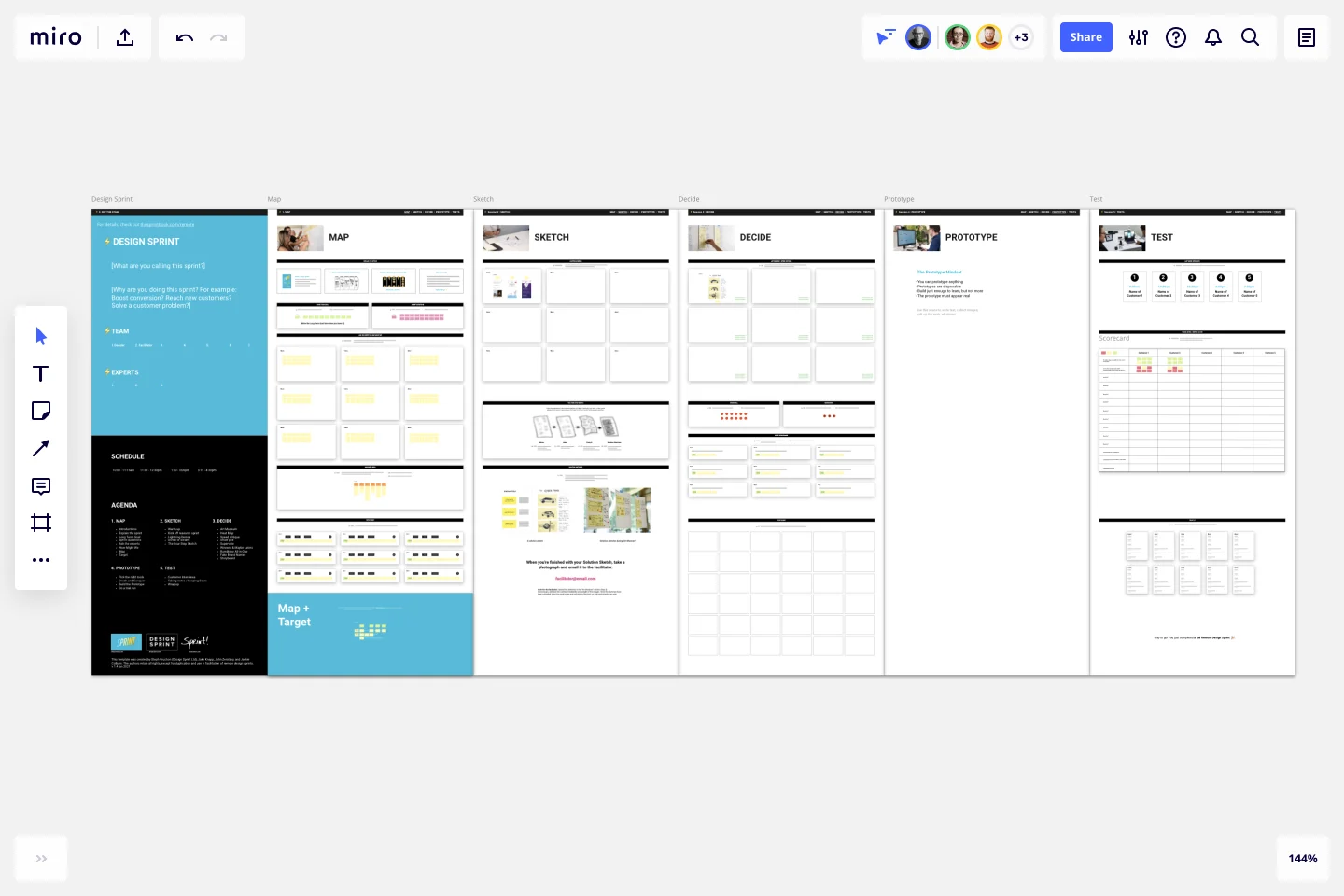Official 5-Day Design Sprint
Use our five-day sprint process to help your team solve problems and test out new ideas.
About the official Remote 5-day Design Sprint template
What Is a Design Sprint?
The big idea with the Design Sprint is to build and test a prototype in just five days. You'll take a small team, clear the schedule for a week, and rapidly progress from problem to tested solution using a proven step-by-step checklist. It's like fast-forwarding into the future.
Why use this Design Sprint template
The experts who literally wrote the book on design sprints created this template, just for Miro. First, facilitator Steph Cruchon of Design Sprint Ltd gathered the agency’s combined experience of physical design sprints and looked for ways to make it efficient and enjoyable in a remote setting. At the same time, the creators of the methodology at Google, Jake Knapp and John Zeratsky, teamed up with Jackie Colburn to write an in-depth guide to run full five-day remote design sprints.
Together, they created this official template for remote sprints, invested personally in writing crystal clear instructions, and even added new exercises that don’t appear in the Sprint book but were part of their workshops. This template works hand in hand with the book and will help you run excellent 100% remote design sprints.
How to use the Design Sprint template
Using the Design Sprint template is easy. Typically how it works is, the facilitator will prep the event before guiding participants through the one big goal for each day of the sprint – to map, sketch, decide, prototype, or test.
For those new to participating in Design Sprints, one of the biggest challenges will be to trust the process. Remember that times it will be overwhelming but that’s part of the process and it’ll all work out.
Miro is the perfect tool to use for your design sprint — remotely or in person. Here’s one way to use it when you're preparing for your next sprint:
Get started by selecting this Design Sprint template.
Read the for advice on tools, preparation, facilitation, and modified tactics.
Give the sprint a name. E.g. “User signup flow.”
Clarify the goal of the sprint. E.g. “To improve the user’s experience as they sign up.”
Ensure you get the right people in the room and assign the roles within the team. Make sure to clarify and brief the role of the facilitator and decider in advance.
Then take the template to the session, because you’re ready to get started!
Invite your team to start collaborating, and don’t forget to share the finished product with the wider company. Be sure to tell everyone about the process and help them understand what you’ve explored and learned about the topic.
How long should design sprints be?
Five days. The design sprint is a **five-day** process for answering critical business questions through design, rapid design prototyping, and testing ideas.
What are the 5 phases of sprint?
Technique training for sprinting can be divided into five areas: starting, acceleration, drive phase, recovery phase, and deceleration
Get started with this template right now.
Service Blueprint Template
Works best for:
Desk Research, Operations, Market Research
The Service Blueprint template is a visual tool for designing and optimizing service experiences. It provides a structured framework for mapping customer journeys, identifying touchpoints, and aligning internal processes. This template enables teams to visualize the entire service ecosystem, uncover pain points, and innovate solutions to enhance customer satisfaction. By promoting customer-centricity and collaboration, the Service Blueprint empowers organizations to deliver exceptional service experiences and drive sustainable growth.
Gap Analysis Template
Works best for:
Marketing, Strategic Planning, Business Management
Consider your team’s or organization’s ideal state. Now compare it to your current real-world situation. Want to identify the gaps or obstacles that stand between your present and future? Then you’re ready to run a gap analysis. This easy-to-customize template will let your team align on what obstacles are preventing you from hitting your goals sooner, collaborate on a plan to achieve those goals, and push your organization toward growth and development. You can focus on specific gap analyses — including for skills, candidates, software, processes, vendors, data, and more.
UX Research Repository Template
Works best for:
UX Design, User Experience
Empower your organization with customer knowledge and build a centralized research hub. From UX designers to product managers, enable everyone to get insights using the Research Repository Template.
Service Definition Canvas
Works best for:
Research & Design
The Service Definition Canvas helps you define and visualize the core components of your service. This template is perfect for outlining service interactions, identifying improvement areas, and aligning teams. Use it to create a clear and comprehensive service blueprint that enhances customer experience and operational efficiency. It's ideal for strategic planning and ensuring a cohesive understanding of service delivery among stakeholders.
Proto Persona Template
Works best for:
UX, UX Research, Product Design
The Proto Persona Template is tailored to capture the essence of hypothetical user segments. It encapsulates key attributes such as user needs, behaviors, and potential pain points. One of its standout benefits is its ability to foster empathy. By visualizing and understanding these preliminary user profiles, design and strategy teams can tap into a deeper connection with their target audience, ensuring that solutions resonate authentically and address genuine needs.
Storyboard for Marketing Campaign Template
Works best for:
Storyboard
The Storyboard for Marketing Campaign template helps you visually plan and structure each scene of your campaign. Outline objectives, visuals, messages, and calls to action for each part, ensuring clarity and impact. Ideal for marketing teams, this template enables effective collaboration, aligns messaging, and maximizes audience engagement through strategic storytelling.
